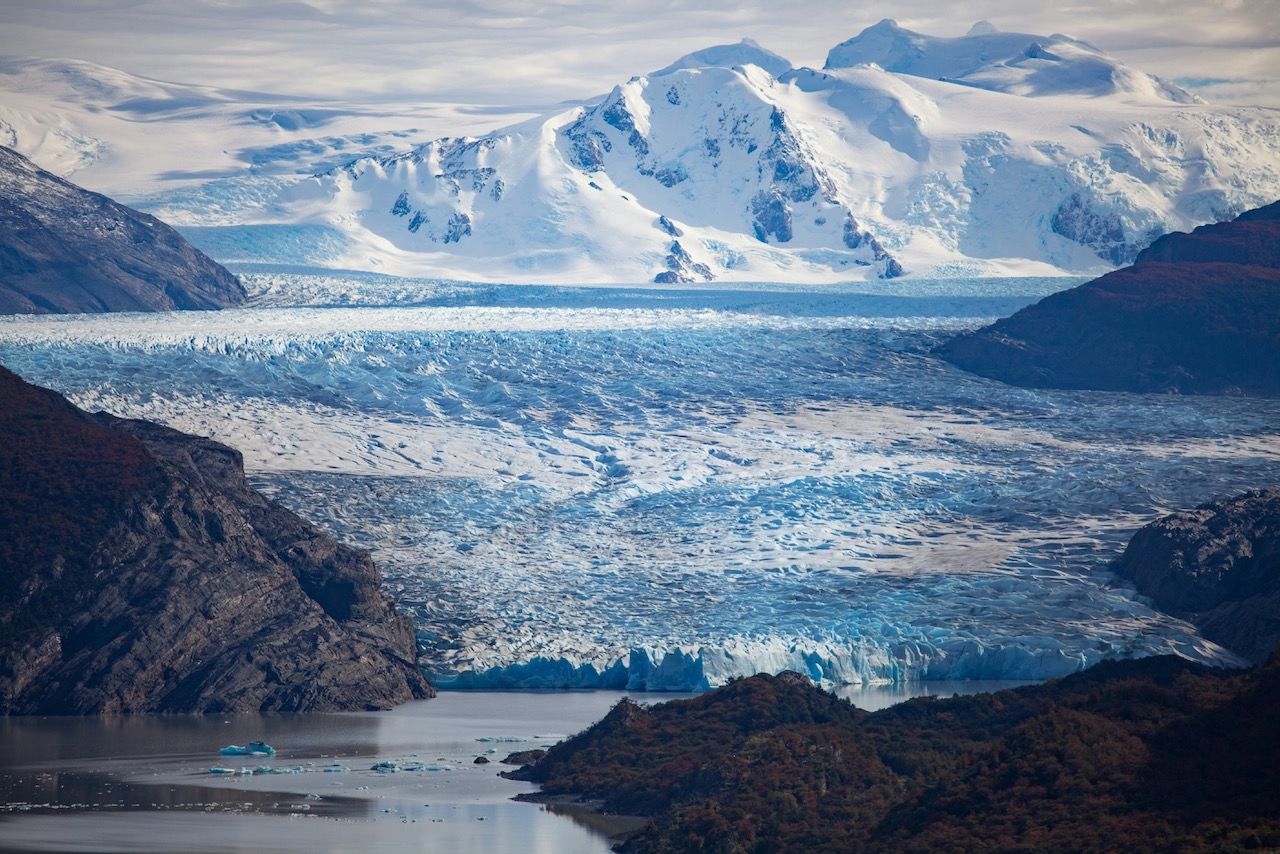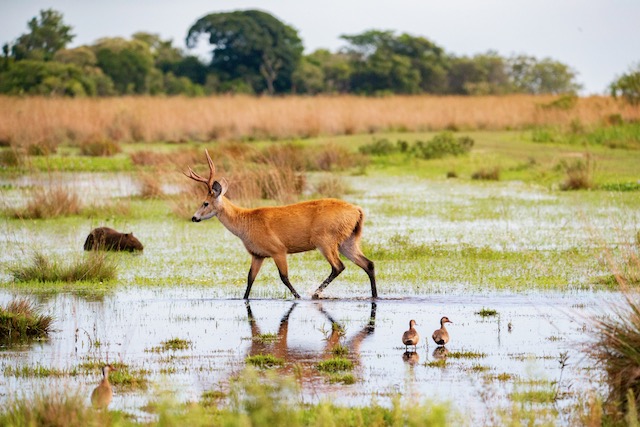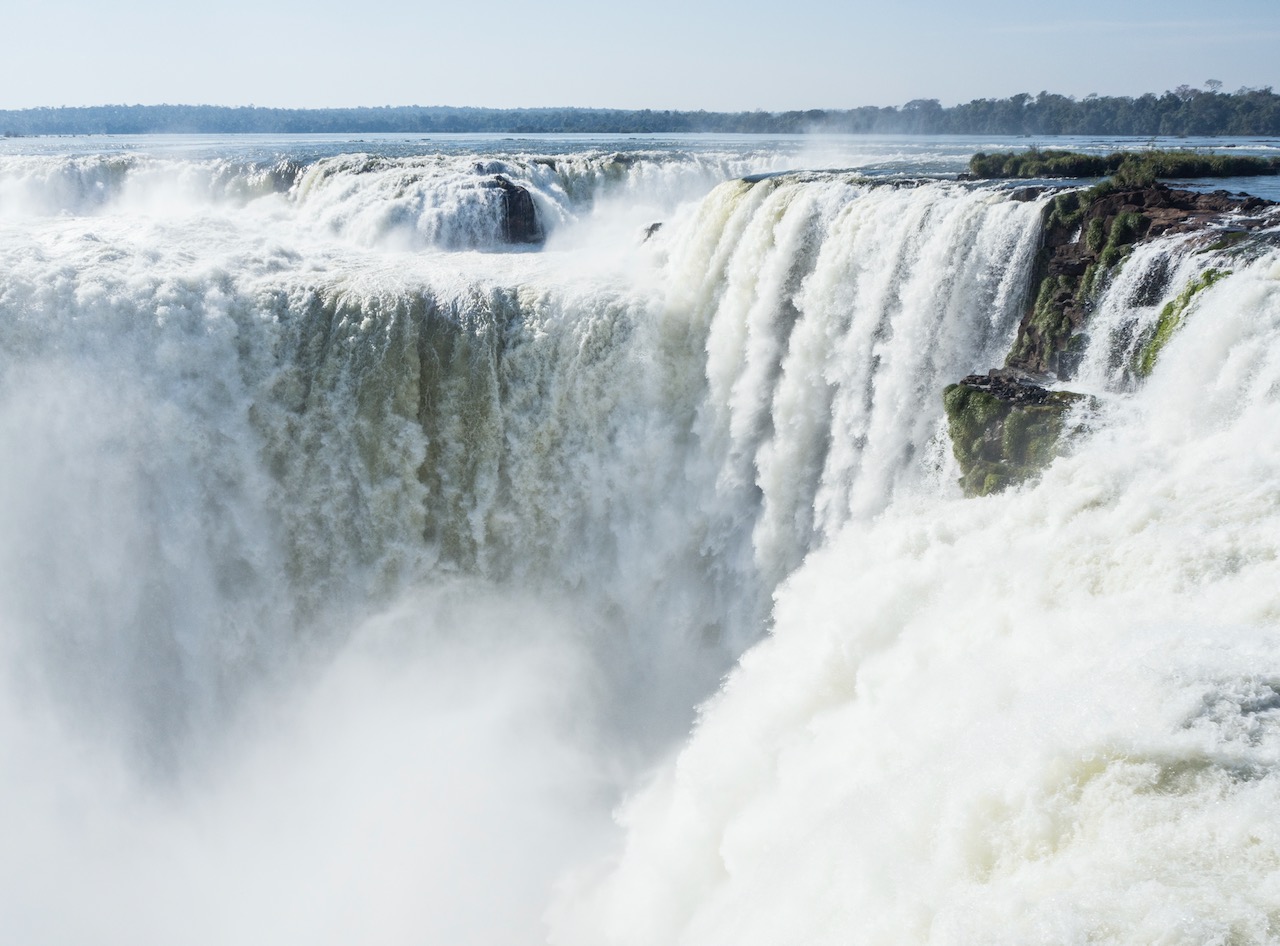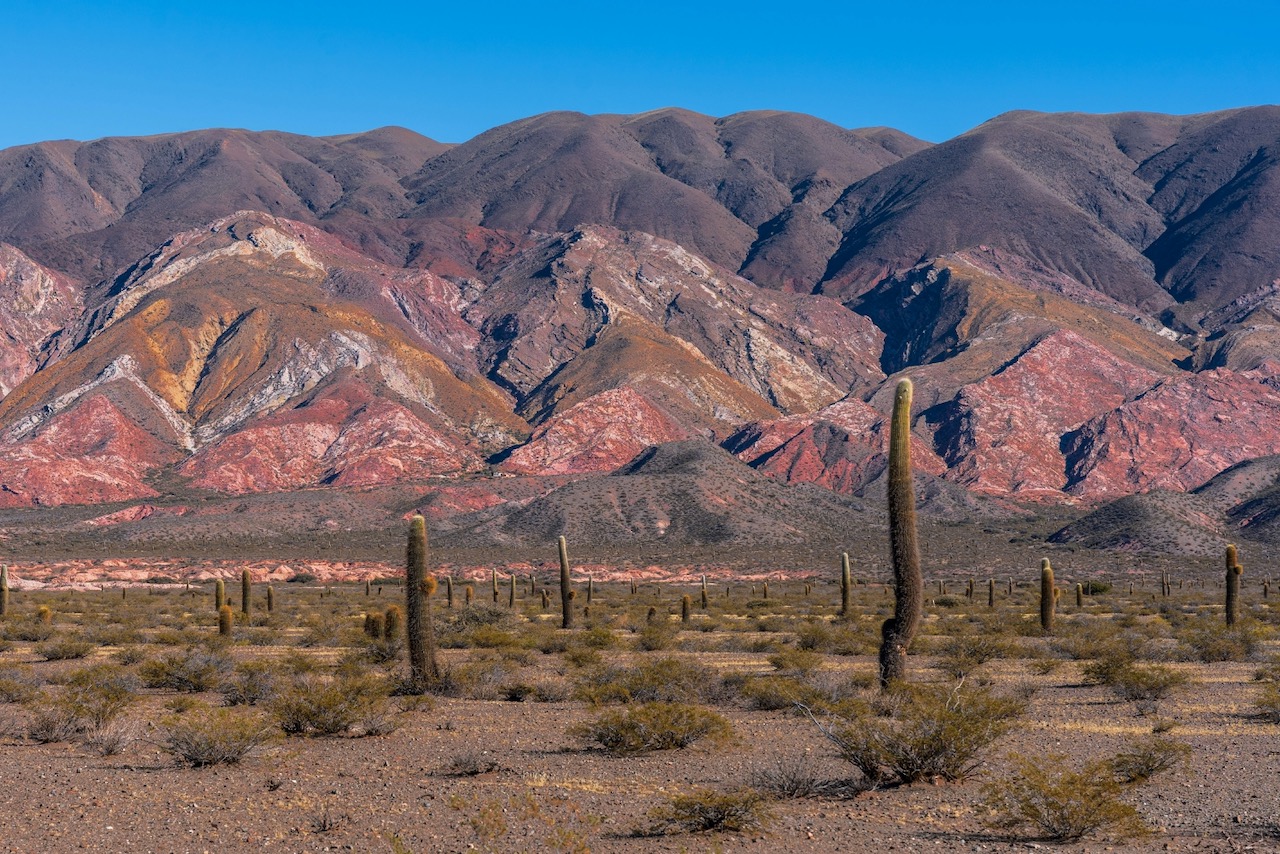August 23, 2024
10 Incredible National Parks to Visit in Chile & Argentina
In a world increasingly impacted by human activity, our planet’s wild spaces are disappearing at an alarming rate. Now more than ever, national parks are essential for protecting our planet’s incredible diversity and ensuring that wildlife survives and thrives so that future generations will also have the chance to explore, enjoy, and be inspired by the wonders of the natural world.
Chile and Argentina are home to some of the world’s most diverse and breathtaking landscapes, with national parks that protect everything from towering mountains and glaciers to vast plains and ancient forests.
We've rounded up ten of our favourite national parks that should be on your must-visit list. Each park highlights the unique beauty and ecological importance of its environment, and are a powerful reminder of how nature, when protected, can flourish.
Conguillío National Park
A UNESCO Biosphere Reserve and part of Chile's first Geopark, Kütralkura, Conguillío protects nearly 150,000 acres of volcanic landscapes, alpine lakes, and ancient Araucaria forests. The remarkable araucaria have been around for over 150 million years, dating back to the time of the dinosaurs. They can live for over 1,500 years and reach towering heights of up to 50 metres.
A favourite among the park’s trails, the seven-kilometre Sierra Nevada Trail commences at the eastern tip of Lake Conguillío and heads up into the Sierra Nevada, a low range of mountains capped with glaciers, offering the most dramatic sweeping views across the park and the ever-active Llaima Volcano.
Getting there: Conguillío is most easily reached via Temuco Airport, with daily flights from Santiago taking about 90 minutes.


Pumalín Douglas Tompkins National Park
At the northern end of the Carretera Austral, this 400,000-hectare national park, created by Tompkins Conservation is a mosaic of lush ancient rainforest, waterfalls, snow-capped mountains, volcanoes, glaciers, and fjords and home to an enormous number of endemic species.
Named after the late Douglas Tompkins, an American philanthropist who purchased vast swaths of Patagonia to restore the land to its natural state, and then donated it back to the Chilean government. It was here that Douglas Tompkins began carrying out his vision of conserving Chilean Patagonia- a vision still very much alive today.
Pumalín is a hiker’s paradise, with a spectacular network of trails that traverse the park’s stunning and diverse landscapes. The Cascadas Escondidas Trail meanders through thick forests to hidden waterfalls and crystal-clear plunge pools. The Volcán Chaitén trail takes you up to the crater of the volcano, while The Alerces trail offers a journey into an ancient world, where you’ll walk among towering Alerce trees, some nearly 4,000 years old.
Getting there: The quickest way to reach Pumalín is by air. Daily flights from La Paloma Aerodrome in Puerto Montt to Chaitén take about 50 minutes.


Cerro Castillo National Park
Just south of the town of Coyhaique on the Carretera Austral in Chile’s Aysen Region, Cerro Castillo National Park is home to some of Chile’s most stunning and untouched trekking circuits. It offers a rare glimpse into Patagonia's raw and pristine landscapes far from the crowds.
Cerro Castillo, a striking mountain of stone and ice, is the park’s centrepiece. Its hanging glaciers feed into deep turquoise lagoons, and the lenga and ñirre forests are home to the endangered huemul (South Andean deer). The park plays a key role in the National Huemul Corridor, a conservation project aiming to restore the huemul population through wildlife corridors along the Route of Parks of Patagonia. In the northern sector of the park, Las Horquetas Valley provides essential wintering habitat and connectivity for huemul groups.
Experience Aysén's rich gaucho culture and unspoiled beauty by exploring the park on horseback, just as the locals have done for generations. Ride along old mountain paths and uncover untouched areas, where forests, mountains, and rivers stretch endlessly without another soul insight.
Getting there: Take a 2.5-hour flight from Santiago to Balmaceda Airport, from there it’s a 90-minute drive to Villa Cerro Castillo.


Patagonia National Park
One of Chile’s most significant restoration and rewilding projects, Patagonia National Park is an impressive example of what dedicated conservation efforts can achieve.
Located 18 kilometres north of Cochrane, the expansive park is made up of the former Tamango and Jeinimeni Reserves, as well as the Chacabuco Valley, which was previously one of the largest livestock ranches in the country before Tompkins Conservation acquired the land and donated it to the state. After a century of overgrazing, today the area boasts one of the highest levels of biodiversity in the Aysén region.
The transformation involved removing hundreds of kilometres of fencing, clearing sheep and cattle, and building infrastructure for public access. This massive effort is considered one of the largest grassland restoration projects ever undertaken. Today, Patagonia National Park offers a range of recreational activities and exceptional wildlife-watching opportunities. Tompkins Conservation leads significant rewilding efforts here, focusing on the recovery of iconic species such as cougars, Andean condors, Darwin’s Rheas, and the endangered huemul deer.
In the heart of the park is Explora Patagonia National Park. Guests at the lodge can witness firsthand the restoration efforts and support continued conservation in this magnificent yet virtually explored slice of Patagonia on adventures led by expert naturalists.
Getting there: The nearest airport is Balmaceda, from here it’s about a 6-hour drive along the beautiful Carretera Austral. For a quicker option, guests at Explora can take a 45-minute private flight from Balmaceda to Cochrane, enjoying panoramic views of General Carrera Lake, one of South America's largest lakes, along the way.


Torres del Paine National Park
Easily Chile’s most iconic national park, Torres del Paine is vast and beautiful at every turn. Famed for its rugged mountainscapes, glaciers, forests, and turquoise lagoons- this is the Patagonia travellers dream about.
Lace up your hiking boots and discover the park’s famous hiking trails and scenic viewpoints, conquer high mountain ascents, explore on horseback with gauchos, go wildlife watching, or hop on a boat for a glacier navigation whilst cruising past floating icebergs. The park’s most popular hike, the W Trek, is a multi-day journey that leads you through the park's highlights, including the Ascencio Valley, French Valley, Grey Glacier Valley, and the famous Base Torres trek, where you’ll be rewarded with views of the three granite spires that gave the park its name.
For a blend of adventure and comfort, a handful of luxury lodges in and around the park offer the perfect base, providing access to some of the park’s most beautiful trails, including sections of the W Trek. After a day of exploring, return to your lodge to unwind in style, enjoying gourmet cuisine, spa treatments, and luxe accommodations with stunning views of Patagonia's dramatic landscapes.
For wildlife enthusiasts, Torres del Paine is also one of the best places on earth to see wild pumas. A puma-tracking experience, guided by experts who know the cats’ movements, offers the best chance to observe these magnificent animals in their natural habitat. A respectful approach ensures that their space is not invaded, as you observe and learn about their habits and the crucial role they play in the ecosystem. This location is also excellent for birdwatching and landscape photography, offering a stunning backdrop of the park’s famous three granite towers.
Getting there: To get to Torres del Paine National Park, fly into Puerto Natales or Punta Arenas. Both are about 3.5 hours from Santiago. Puerto Natales is closer to the park (a 2-hour drive) but has limited flights, while Punta Arenas has more frequent flights. From Punta Arenas, it’s a 3-hour journey to Puerto Natales, plus the additional transit time to the park.


Iberá National Park
Argentina's wetland wonderland, Iberá National Park is one of South America’s greatest untouched wildernesses. Once under threat, today it is a sanctuary for endangered species and a catalyst for positive change within local communities.
Where crystal-clear lagoons meet marshes, a stunning collection of wildlife thrives, including more than 300 bird species, playful capybaras, pampas deer, and howler monkeys. There are endless opportunities for great wildlife watching with expert guides on foot, by boat, kayak or on horseback.
Iberá's story is another remarkable example of successful conservation. In the late 1990s, conservationists Douglas and Kristine Tompkins recognised the urgent need to protect and restore this crucial landscape. They acquired unprotected lands and launched a major restoration project through their organisation, the Conservation Land Trust (CLT). Their efforts focused on reintroducing native species that had been locally extinct or endangered, such as the giant anteater, jaguar, collared peccary, and scarlet macaw. This ambitious rewilding project has made Iberá the largest of its kind in Latin America.
Getting there: From Buenos Aires, you can fly to Posadas followed by a 4-hour drive to the park.


Iguazú National Park
Located along the Iguazu River, which forms a natural border between Argentina and Brazil, Iguazú Falls is a UNESCO World Heritage Site and the crown jewel of Iguazu National Park. Flanked by lush subtropical rainforest, these magnificent falls are a breathtaking spectacle, composed of hundreds of cascades where the river plunges over 200 feet in a thunderous display of whitewater and mist.
The majority of the falls lie on the Argentine side, offering more trails and varied viewpoints that bring you so close to the thundering waters that you’re likely to get soaked. For an adrenaline rush, hop on a speed boat tour to see the falls from below and experience their power from a unique perspective. While Argentina offers the most up-close experiences, you can hop over the border to Brazil for stunning panoramic views of the entire falls.
Beyond the waterfalls, the national park spans 700 square kilometres of subtropical forest to explore. Explore the park's extensive network of trails, each offering a different perspective of its stunning landscapes for a quieter experience where wildlife thrives. Keep an eye out for colourful birds, butterflies, capuchin monkeys, and even the occasional coati or anteater.
Getting there: From Buenos Aires, you can take a 2-hour flight to Puerto Iguazú Airport followed by a 30-minute drive.


Los Glaciares National Park
A UNESCO World Heritage Site, Los Glaciares National Park is one of Argentina’s most-visited national parks for good reason. Spanning a large portion of the South Patagonian Ice Field, one of the largest ice fields in the world, this park safeguards some of the planet’s most dramatic landscapes.
The park’s northern section is home to El Chaltén, Argentina's trekking capital. Nestled at the foot of the Fitz Roy Massif and Cerro Torre, this town is a hotspot for hikers and mountain climbers. With trails that start right from the edge of town, trekkers are treated to breathtaking views of jagged peaks, shimmering lakes, and evergreen forests.
Further south is El Calafate, known as the 'gateway of the glaciers.' This bustling town serves as the main entry point to Los Glaciares National Park, offering easy access to its impressive collection of glaciers, including Viedma, Spegazzini, Upsala, and the massive Perito Moreno Glacier. Perito Moreno is one of the few glaciers in the world still advancing. As it grows, massive chunks of ice break off with a thunderous crash into the waters below, creating a spectacular display. Visitors can explore this natural wonder from various angles, thanks to a network of boardwalks and viewing platforms, or sail or kayak along its towering front wall. For a truly unforgettable experience, hike across the glacier’s icy surface and discover its surreal blue lagoons, unique ice formations, and impressive ice caves.
Estancias in the park offer a unique way to experience the region’s rich gaucho culture, and history against a stunning backdrop of mountain peaks and infinite steppe. Discover the history, culture, and day-to-day routines and realities of rural life. Connect with locals, participate in farming activities, watch the gauchos herd cattle and shear sheep, and ride horseback across open fields to explore the vast and varied landscape.
Getting there: The gateway airport for Los Glaciares National Park is El Calafate a three-hour flight from Buenos Aires. It's popular to combine visits to Los Glaciares National Park and Torres del Paine National Park, with the option to travel overland by road from Puerto Natales.


Los Alerces National Park
Declared a UNESCO World Heritage Site in 2017, Los Alerces National Park is a hidden Patagonian gem home to the trees of the same name which are among the longest-living in the world. The park is a critical area for conservation, established in 1937 to protect these remarkable trees, some over 3000 years old, which face threats from deforestation and climate change.
The National Park is a pristine wilderness with a breathtaking blend of turquoise lakes, rushing rivers, glaciers, and waterfalls, all framed by lush ancient forests. Outdoor enthusiasts will find endless opportunities to explore. The park is a paradise for activities like hiking, fishing, kayaking, and wildlife watching. Trails wind through the forest, offering glimpses of the region’s rich biodiversity, including native flora and fauna.
Getting there: Located in Chubut Province, Los Alerces National Park is about 50 kilometres from Esquel which is a 2.5-hour flight from Buenos Aires.


Los Cardones National Park
Los Cardones National Park is a hidden gem in Northeast Argentina perfect for a quick stop or a self-guided adventure. Home to one of the largest cactus forests in South America, the park is dominated by the towering cardón (candelabra cactus). It offers a stunning mix of Andean high desert beauty—think dramatic mountains, sweeping plateaus, and vibrant rock formations. The park is also home to over 100 bird species, including the impressive Andean condor. Visitors might also spot wildlife such as guanacos, vicuñas, grey foxes, and chinchillas.
Getting there: Los Cardones is located just 97 kilometres from Salta. The views and colour palette of this park are best enjoyed during the scenic drive from Salta to Cachi.


